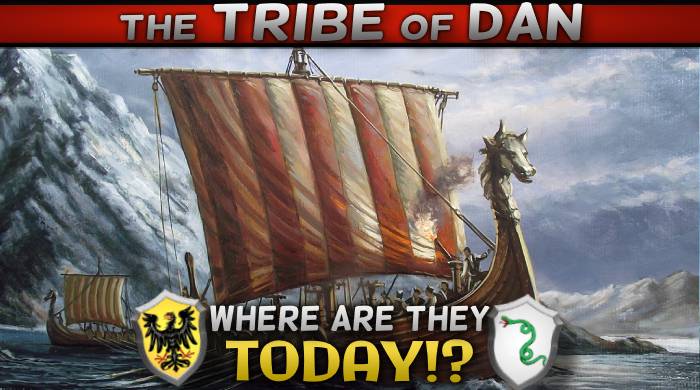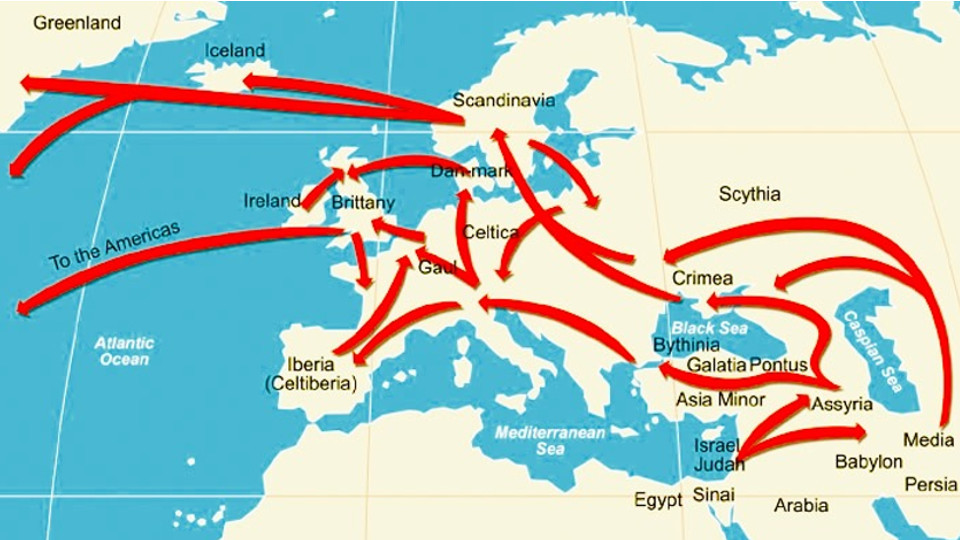100 Proofs The Israelites Were White Part 1
We Europeans are everywhere. Of course, we’re mostly in Europe, the British Isles, North America, Canada, Australia, New Zealand, South Africa, Russia, and other white countries that we have founded and where we belong (and where all third-world people want to move). On every continent and in every corner of the world, you’ll find the descendants of white Europeans. Wherever we’ve gone, we have thrived and built Christian civilizations based on God’s laws rather than the law of the jungle. Non-whites have never been able to achieve this on their own. Even if whites establish a Christian civilization for them, they cannot maintain it (unfortunate South Africa is but one example).
However, we whites have not always been scattered across the world. We did not always live in Europe; nor were we always called Europeans. To rediscover our forgotten origins, we must go back to God and His Scriptures. Our presence across the earth and our unparalleled accomplishments of Western Civilization were prophesied in the Bible long ago when Yahweh made His covenant with Abraham, who was white, and to Abraham’s white progeny. It has always been our God-given destiny to be the greatest race to ever walk the earth. Long before we migrated to Europe, we lived in the Middle East. That was over 2,000 years ago. And, yes, the Middle East was white back then, and this is where we were born as a people. We whites were and still are the original Biblical Israelites. We are Abraham’s genetic children, the people with whom God made His covenant.
How did this expansion from the Middle East to Europe happen? Fundamentally, it began when the Israelites were freed from slavery in Egypt. As we well know, most Israelites followed Moses into the Sinai Desert and forty years later, conquered the land of Canaan. But not all the Israelites went with Moses. A sizable group broke away when they first left Egypt and this group set sail for Europe. The others followed Moses. Then some years later, in conquered Canaan, another swath of Israelites — descendants of the Israelites who had followed Moses — migrated during the Judges and Kingdoms periods and also set sail for Europe. We know about these migrating Israelites from ancient secular history and stone inscriptions rather than from the Bible, which focused on the Israelites in Canaan.
However, the largest migration came with the Assyrian deportations in 722 BC, when masses of our Israelite ancestors were uprooted from the Promised Land and resettled near the Caucasus Mountains. Some of these Israelites stayed in the Caucasus area and eventually became the Parthian Empire, but large numbers migrated over the Caucasus mountains and into Europe. These Israelites morphed into the multitude of Germanic tribes who swarmed across Europe and eventually conquered and destroyed the Roman Empire. Since our purpose here in Proof 1 is to show that we white Europeans are the Biblical Israelites, we’ll concentrate on these later migrations of Israelites who became the Germanic tribes. We’ll cover Israel’s earlier migrations in later Proofs.
These migrations are our forgotten beginnings as white Europeans. Our journey as a race happened under the direction of Providence and according to prophecy. We did not indigenously sprout up across Europe as Frenchmen and Italians, Londoners and Dubliners, Swedes and Finns. All of these modern white nations and designations grew from the same genetic root: the tribes of Israel. Europeans of all stripes share the same ancestors. Those ancestors were the adventuring Israelites tribes who came crashing onto the European landmass all those centuries ago. As their numbers multiplied, they split apart into their own territories and their own unique tribes but were collectively known as the Germanic tribes. Our Germanic forefathers became the Franks, Saxons, Angles, Frisians, Danes, Swedes, Goths, Vandals, Lombards, Celts, and many other tribes. With the eventual advent of Christianity, these peoples founded new nations and built the greatest civilization (Western Civilization) ever to exist.
These original Germanic tribes, they are our people. We come from them and we carry their genetic heritage to this day, and yet, most of us do not know our own identity. This means although we may refer to ourselves as English, or French, or American, and so on, in reality, we are men and women of the tribe of Dan, or Judah, or Ephraim, or one of the other twelve tribes. We have forgotten our ancestry, and we have assumed new nationalities. To remedy this unfortunate situation, let’s take a closer look at the story of the Germanic tribes, which is really our story. Our ancestors did come from Europe nor did they “evolve” within Europe from primates and Neanderthals, as we are misinformed by pagans, antichrists, and secular white nationalists. We white Europeans are not chimps out of Africa nor pond scum. We have very deep, very ancient genetic roots, in another land. Certain peoples who have different and antagonistic roots would prefer that we remain ignorant of our real early history.
In the books of Chronicles in the Bible, we read that the Israelites were conquered and deported by the Assyrians around 740 BC. Empires such as Assyria used deportation to subdue and control conquered nations. Once defeated, the Isaelites were deported into regions just below the Caucasus Mountains. Those displaced Israelites are sometimes called the “lost tribes,” but that’s a false designation. How lost or misplaced could these people have been if we know they were settled near the Caucasus Mountains? It wasn’t the tribes who were lost; it was the memory of their identity as children of Israel that was lost. In these Proofs, we intend to reclaim that identity.
The Assyrian Inscriptions
Click image for larger version Name: u-https-tse3-mm-bing-net-th-id-OIP.jpg Views: 0 Size: 57.1 KB ID: 114983
The important question is, what happened to these people? Does their story end with their deportation? If they eventually forgot that they were Israelites, did history also forget them? Indeed, history did not forget our ancestors. We can be thankful that their story has been preserved in the many stone inscriptions and other historical landmarks and findings that modern archeology has dug up during the past two hundred years. In these two centuries, archaeologists have unearthed in many Biblical locations the story of the lost tribes. One such site is Ninevah, the ancient capital of the Assyrian Empire. Many stone pillars and tablets have been unearthed and, you might say, these stones talk and narrate our ancient history. When translated, these records show that the Assyrians, the Persians and Medes, the Babylonians — all talked about in the Scriptures — really did exist. The Assyrians really did conquer Israel and really did deport millions of Israelites.
But the narrative isn’t always straightforward due to the fact that the Israelites weren’t always referred to as Israelites. Different peoples called them by different names. For instance, these Assyrian records called the Israelites by the name of Cymri or Bit Cymri. If you’re coming across this information for the first time, you might be thinking: “How is he getting Israelite out of Cymri? These words don’t sound alike at all.” And you’d be right. They don’t. That’s because the names Cymri and Bit Cymri come from the Assyrian perspective and tongue. The Assyrians called their captive people (the Israelites) by the name of the King of the Northern Kingdom of Israel at the time. This was the famous King Omri (his name has also been translated as Humri and Amri). The Assyrians transliterated the name into Cymri and Bit Cymri (possibly due to a harsh guttural beginning “c” sound in the original Hebrew). “Bit Cymri” means “the house of Omri” or “the people of Omri.” King Omri, his reign, conquest, and deportation can all be found in the Bible in I Kings (3 Kings in the Septuagint, LXX) Chapter 16.
It should be noted that in older translations of the Bible, King Omri used to be spelled King Cymri. However, since it was pronounced with an initial guttural “gggg,” it’s likely that people other than Hebrews had difficulty pronouncing the word, and hence the Assyrians went with a modified transliteration they could pronounce more easily, Cymri. In the King James Bible (by the 17th century), the translators decided to modify certain spellings in order to simplify pronunciation; as a result, they modified many words such as Cymri to start with a vowel instead of a consonant. This is the reason why we have King Omri in our Bible, but the Assyrian inscriptions call him Cymri.
Evolution of Cimmerians to Scythians and Galatea
Click image for larger version Name: Lost-Tribes-Names-1.jpg Views: 0 Size: 124.6 KB ID: 114981
During the reign of the Assyrians, the Israelites became known as Cymri. The Assyrian Empire was vast and far-reaching, therefore the lingua franca (the common language, especially for trade) was Akkadian (the Assyrian language), so other surrounding nations also began to call the Israelites by these names, although in their own transliterated versions. The Greek historians called the Cymri by the name of Kimmerioi (Κιμμέριο) which modern translators anglize to Cimmerians. These same Greek historians tell us that these Cimmerians migrated out of Assyria, from the regions to which the Israelites had been deported, and that they eventually migrated into Europe. Since the Greeks lacked a guttural sound in their language, they pronounced the name Cimmerians with a “C” as we would say “kill.” The Romans used a “k” instead of a “c” and so called them Kimmerii.
It would certainly be easier if the traveling tribes of Israel were always called by the same name, but they weren’t. We have to deal with that historical reality. The early changing of their name is understandable, and perhaps to be expected. After all, conquered and dispersed people generally do not get to insist on their own name. With the passing of many generations in new lands, the original name may have passed from memory. As the tribes of Israel pushed farther into Europe, their name was modified again and again by people with yet another language.
Nevertheless, we can track the names historically, and the evolution of their name tells a fascinating story in itself. The Babylonians transliterated Cymri to Khumri, thus the name remained virtually identical. The Persians however called the Cymri/Khumri by a new name altogether: the Saka/Sacae (Sakā) or Saka Suni, which means the Sons of Saka (some people believe Saka is a shortened form of Isaac). From the Saka Suni, we get the more modern name of Saxons which is still with us to this day. Saxons is a combination of Saka and Sons.
The evolution of names doesn’t stop there. As the Cimmerians or Saxons invaded more of Europe, they gained two more names: Scythians (Scythae/Σκύθο) and Galatians (Galatae/Γαλάται). Scythians means “tent dwellers,” and the Israelites may have given themselves this name because they were nomads and therefore did indeed dwell in tents. “Scythian” is a corruption of the Hebrew word “succoth” meaning tent. Galatae was a name given them by the Greeks and may be related to the word “milk” since the Hebrews lived on the products of their cattle. Since the Greeks drank primarily wine and not milk, the Greek historian Homer mocked the Galatae for being milk drinkers. Eventually, these Israelite tribes who were now called Scythians and Galatians spread out all over Europe, to the east, to the north and west. By around 300 BC, some tribes began raiding Northern Italy and after numerous victories against the Romans, they sacked Rome. The Galatians, who had taken part in the destruction of Rome, were eventually repelled and moved into what we call France today. The Romans shortened the name Galatae to Gauls (Galli).
The Germanic Tribes
Click image for larger version Name: u-https-c4-wallpaperflare-com-wallpaper-938-596-44-roman-empire-painting-vercingetorix-vercingeto.jpg Views: 0 Size: 131.7 KB ID: 114982
Now we come to the final name: the Germanic tribes. None other than Julius Caesar gave us this concluding name that has lasted until today. Caesar distinguished between the Gauls (Galatea) who had settled in today’s France and intermixed with the native population and the Gauls who settled in the region now called Germany. France at that time was called Celtica, as Celts lived there. The Gauls in what we call modern France occupied a region originally called Celtica, which had been previously settled by the Phoenicians (another Hebrew tribe who had arrived in Europe much earlier) and the Gauls and Phoenicians likely merged with each other. But it should be noted that this “intermixing” is Julius Caesar’s perspective. He thought of the Phoenicians/Celtica as a different tribe or race than the Gauls. But in fact, these two tribes were both originally Israelites. Caesar called the latter Gauls in modern Germany (who had not mixed with any previous tribe since they were the first settlers in those cold lands) Germani, meaning “genuine,” “authentic,” “true,” and “sincere.” He perceived these Germani as a purer breed than the Gauls in France. The tribes in Germania — the Saxons, Scythians, and Cimmerians — would gradually adopt their new name of Germania or the Germanic peoples.
The first-century Greek historian and geographer of the Greek and Roman worlds, Strabo, described the Germans or all of Germania as an enormous mass of people beyond counting who inhabited the lands beyond the western Rhine and as far as the Black Sea. Essentially this shows that at that time, the landmass from the border of France all the way to the Black Sea was all considered Germania. In other words, the Germanic, Cimmerian, Scythian people controlled and occupied all of the territories north of the Roman Empire, what we today consider Central and East Europe. Historians such as Pliny the Elder further verify this. Pliny recounts that the people known as Germans or Germani were also called Scythians and Cimmerians. “The name of the Scythians is everywhere changed to that of Sarmatae and Germans,” he wrote (The Natural History of Pliny the Elder, Book 4, Chapter 25). These historical documents prove that these people were all one and the same people no matter what name was attached to them.
To sum up the transformation of the Israelites into Europeans: After being deported by the Assyrians, the Israelites migrated from Assyria and Media through the Caucasus Mountains. From there, they traveled into Europe and became known as the Germanic tribes. Later, they solidified into the modern European peoples and nations. That is why today Europeans are collectively called Caucasians. We white Europeans came from these Germanic tribes. Our people were originally deported from the lands of Israel and Judah. Thus as we trace our lineage back in time, we can know with certainty that we are the Israelites, the descendants of Abraham, Isaac, and Jacob. We are the people of the Bible. We are the inheritors of the Biblical promises and prophecies. There is no true Christianity without a true understanding of this ancient history. We are the Children of God and the Bible is our history and no one else’s.



